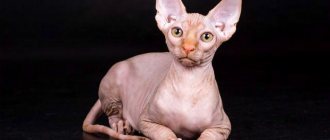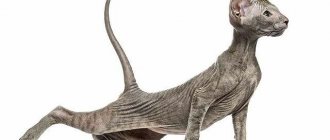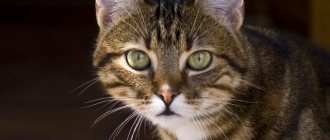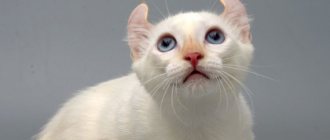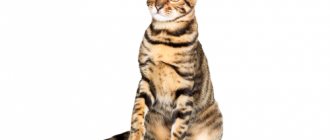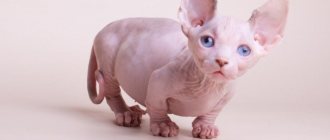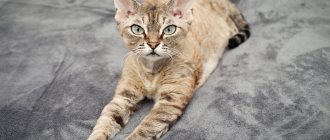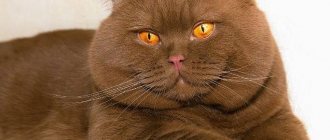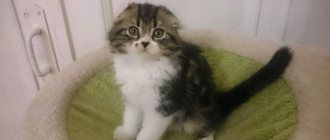Despite their atypical appearance for felines, sphinxes continue to win our hearts, becoming more and more popular among cat lovers every year. However, hairless cats continue to be quite rare due to the limited gene pool.
Why the Sphynx cat is still a curiosity, where hairless cats come from, what kittens from a Sphynx and an ordinary cat will be like, as well as many other features of the breed varieties will be covered in this article.
Varieties of Sphynxes - breeds with photos and names
If you still think that the Sphynx is one breed, then this article is for you. Officially, felinological associations recognize three varieties of hairless cats. We will talk about them in this article.
Note! There are also breeds of hairless cats that are not recognized by felinological associations. For example, the Bambino (a cross between the Sphynx and the Munchkin) and the Ukrainian Levkoy.
Canadian Sphynx (moon cat)
Canadian hairless cats have become the standard among other branches of hairless cat breeds. The founder of the breed in 1975 was a completely hairless kitten born from a short-haired mother.
A little later, his hairless sister was added to the first one, born a year after the significant birth of the most famous hairless cat. The naked babies were bought by the Z. Stardust nursery, the first hairless kittens became the founders of the most elite branch of the breed, their descendants are distinguished by their impeccable exterior and unparalleled “velor” skin.
Don Sphynx
Donchak is a much younger breed than Canadians. Don or Rostov hairless cats are a domestic breed, bred in Rostov-on-Don, recognized much later than their hairless overseas relatives from Canada. As an independent breed, Rostov Sfin cats received recognition in 1980.
Peterbald (Petersburg Sphynx)
One of the youngest branches of the Sfin cat breed is considered to be a breed bred in St. Petersburg. A new branch was created by crossing an Oriental cat and a Donetsk Sphynx in 2003.
Nutrition
When using ready-made food, preference is given to super-premium or premium products - they are individually selected for kittens, castrated, sterilized and pregnant pets.
A diet of regular products is selected with a specialist and should include:
- lean meats and offal, previously frozen or processed with boiling water;
- boiled sea fish - 2-3 times a week;
- vegetables;
- cereals;
- cottage cheese, kefir or fermented baked milk – 2 times a week;
- eggs, preferably quail and hard cheese – once a week.
The products are introduced one by one and in small portions, so that if an allergic reaction occurs, the cause can be easily determined. To replenish energy, the majority of your cat's diet should be high-carbohydrate foods.
You should not give sphinxes:
- legumes;
- potatoes;
- pork;
- sausages;
- fat;
- sweet;
- salty;
- smoked food.
With a natural diet, you should additionally select a vitamin complex with a veterinarian and give it in a course once every six months.
Advice! If a cat eats natural products, he needs to brush his teeth and give him a cracker to chew 1-2 times a week to remove plaque.
Features of cats without hair
According to legends, the Egyptian Sphynx cat escorted the souls of the inhabitants of Ancient Egypt to the afterlife. According to legends, among the Aztecs, unusual hairless cats with large ears evoked reverence and respect. Allegedly, Aztec cats lived at temples, and the Aztecs revered hairless cats with large ears as divine beings.
The owners of modern Sfin cats jokingly prefer to classify their pets as alien creatures. Some owners simply say that sphinxes are magical cats. By the way, it’s hard to disagree with this statement. Everyone has long known the healing abilities of cats: cats find a sore spot on their owner, diligently knead it, massage it, and then lie down on the source of pain to warm it with their natural warmth. So, among Sfin purrs, these abilities of home healers are doubled due to the contact of the hot skin of a hairless cat with human skin.
Cats without fur need to be fed more often than their furry relatives. To maintain the necessary thermal balance of the body, the Sfin cat requires more frequent feeding and much more food than a purring cat with fur.
Sphynx body temperature
As for small hairless kittens, the normal temperature for them is 38.5-39.5⁰C. Metabolism in babies is higher, metabolic processes occur faster than in adult animals, therefore the normal body temperature in kittens is higher than in mature individuals.
In adult hairless cats and hairless cats, the normal body temperature is 38-39⁰C.
Do sphinxes have mustaches?
Many sphinxes either have no whiskers at all, or they are broken off or curled. In some Sphynx cats the whiskers fall out and grow back. Moreover, the process of loss and regrowth of whiskers in Sfin cats is a very individual matter, not amenable to any predictions.
In the language of zoologists, cat whiskers are called vibrissae; for purrs, this simple-looking device works both as protection from external dangers and as a means of navigation.
Cats are nocturnal animals and love to hunt in the dark. To recreate a complete picture of the environment, the cat uses sensitive antennae, with which it is able to detect air currents and vibrations.
If a cat's whisker touches any object, the purr will immediately trigger a defensive reaction - the cat will reflexively close its eyes. What if the obstacle touched by the vibrissa turns out to be a sharp branch, wire or some other dangerous object? Nature took care of the soft-footed meowing hunters, providing them with an additional organ of touch in the form of sensitive vibrissae.
Any Sphynx cat, although a representative of the cat family, is not a night hunter. A hairless cat is unable to survive either in the wild or on the street: it is an exclusively decorative creature bred to be kept at home. Such a pampered, whimsical animal does not particularly need a hunting attribute in the form of sensitive long whiskers.
Sphinx tail
The tail of a healthy animal should be flexible and mobile, thick at the base, gradually tapering towards the tip. Sphinxes often curl their sensitive whip-like tail into a ring, which adds even more mystery and piquancy to their unusual appearance. At the tip of the tail, sphinxes are allowed a “lion tassel” - a small tuft of hair.
Unfortunately, this part of the body in hairless cats can be problematic and bring a lot of inconvenience to the pet and its owner.
- Problem one: Anomalies, deformations and other defects of the tail, both congenital and acquired. A Sphynx of any breed that has an underdeveloped, deformed or broken tail will not be allowed for breeding. But that’s not so bad – not all pets can be the stars of a show. The trouble with congenital tail deformation is that a “broken” tail may turn out to be the tip of the iceberg, under which many diseases are hidden that threaten the health and even the life of the animal.
- Problem two: Angular cystic acne, acne, comedones. Both young animals during puberty and mature animals actively involved in breeding are susceptible to these unpleasant skin diseases.
The first of these misfortunes disfigures the cat's tail; angular cystic acne results in persistent scars that are almost impossible to remove with any absorbable ointments.
On the affected areas of the skin, cystic cavities filled with pus are formed; the inflamed foci can merge with each other and open out through the fistula tracts. The disease lasts a long time; a shell of keratinized skin particles and exudate forms on the inflamed areas.
Acne and comedones are more often observed in hairless (rubber) cats. To prevent acne, hairless animals are bathed in a decoction of chamomile or string. Also, do not forget to regularly wipe your pet’s tail with a special degreaser.
Do Sphynxes have fur?
Yes, there are.
According to the breed standard, only the Canadian Sphynx does not have varieties with fur. The animal's skin should have only minimal invisible fluff. There is short pubescence on the muzzle.
But domestic cats - the Peterbald and the Don Sphynx - according to the breed standard, allow individuals with different types of hair. We will talk about them in detail in the next section.
Did you know that a hairless cat can give birth to a fluffy kitten? In some individuals it falls out over time, while others remain fluffy.
Types of Sphynxes with fur
These types apply only to St. Petersburg and Don sphinxes:
- Brush . The coat of the Brush species can be either hard or soft and silky to the touch. The length of the hair is 2-3 mm. The coat can be straight and wavy, or crimped and hard, reminiscent of an old brush that has served its purpose.
- Flock . The skin of a flock animal is covered with tiny short hairs, reminiscent to the touch of a peach skin. As a rule, flock cats walk “in clothes” made of peach fluffs until they are 1.5-2 years old, then they completely “undress”.
- Velor . If you touch a velor seal, you are left with the feeling of touching velor or thin, very high-quality suede. The length of the hair is 2-3 mm. The fibers of velor individuals are much more noticeable than the tiny flock, barely visible to the human eye.
Why are sphinxes bald?
Genetics played a major role in the development of hairless cat breeds. Sphynxes are cats without hair, bald, cute mutants with an unusual appearance caused by the hairlessness gene. This mutation gene has long been tested by felinologists for stability, however, a hybrid of a Sfin cat and an ordinary cat is not always born bald.
Calico CALICO
Varieties:
- White CALICO: white with spots of black and tan. White color predominates on the lower parts of the body.
- Van CALICO: white shade mixed with red and black spots, present on the limbs, head, tail. One or two small spots of color on the body are allowed.
- Dilute CALICO: white color with grayish-blue, cream spots. Predominant on the lower parts of the sphinx's body.
- Dilute Van CALICO: white with blue, cream, red spots located on the legs, tail and head. One or two small spots of color on the body are allowed.
How does a Sphynx get along with other cats?
Hairless cats and cats get along well in pairs with individuals of their own species. Touchingly hugging their paws, they love to cuddle, lick each other and show mutual care in every possible way.
Sphynxes have a friendly character, so they do not get into trouble with other pets and do not arrange for division of territory. The only thing that a bald cat cannot share with another cat is the love of its owner. Sfin cats require more attention to themselves than other pets.
“Master, have as many cats as you want, but love only me!” - this is the motto of the naked cat.
Character
Sphinx personality traits:
- Sociability - pets are very attached to the owner, preferring to sleep in their arms or under a blanket on the bed. Cats always greet their owner, they are touchy, but they don’t hold a grudge for a long time. Sometimes a pet's behavior can be overly annoying.
- Playful is an active animal, often getting into mischief at a young age. Due to the lack of fur, sphinxes are not recommended to be taken outside, so it is important to pay enough attention to your pet. In its absence, the cat becomes lethargic and apathetic. They easily find a common language with children.
- Intelligence - Sphynxes quickly get used to the tray and are easy to train. They can be taught to fetch toys, lie down, or stand up on command.
- Lack of aggression - if a cat doesn’t like something, the animal will prefer to hide rather than start scratching or biting.
The St. Petersburg and Canadian Sphynxes are considered the most “talkative,” while the Don variety of cats is considered the most silent. Like other types of cats, sphinxes are characterized by a love of boxes, excessive curiosity and a wary attitude at first towards new people or other animals.
How much does a hairless cat cost - price in Russia
Only three breeds of hairless cats are officially recognized by feline dog associations:
- Canadian Sphynx. The price of a kitten, depending on the class and elite status of the parents, varies from 8 to 100 thousand rubles.
- Don Sphynx. The price of a kitten varies from 9,000 rubles to 30,000 rubles.
- Peterbald. The cost varies from 5 to 25 thousand rubles.
There are also unrecognized breeds of hairless cats, for example, the Ukrainian Levkoy or the Bambino. However, despite the “unrecognition”, you won’t be able to buy a hairless cat on the cheap. Bambino will cost an average of 20-50 thousand rubles, and Ukrainian Levkoy - 10-20 thousand rubles.
Pros and cons of sphinxes
Positive aspects include the high intelligence and docile nature of hairless cats, their affection and devotion to their owners - it’s not for nothing that sphinxes are called “kissing” cats.
Some breed lovers consider the negative aspects of keeping sphinxes to be their increased love for tactile contact. Occasionally this “alien miracle” shows excessive intrusiveness; not all people will like a cat’s butt sitting on their own face. By placing his hot butt on the owner’s head, or even on the owner’s “face,” the naked cat believes that in this way he will express his boundless love much more clearly. And you will have to come to terms with this - the cat is a “kisser”...
The history of the origin of the breed - how hairless cats appeared
The first Don Sphynxes appeared from a half-haired cat of unknown origin, which was found in a trash heap by a kind-hearted Rostov woman. The woman tortured the found half-sphynx with procedures aimed at restoring the fur until she came to terms with the fact that no medicines or ointments help return the coveted fur to the found purr. In the end, the pussy was left alone, and later she brought hairless kittens from an ordinary short-haired cat, which became the founders of the breed of the first domestic sphinxes.
A similar story happened in Canada, when a hairless mutant kitten was accidentally discovered on a farm. “Rostovite” and “Canadian” are two opposite branches that have different genotypes; these two types of sphinxes do not cross with each other.
There are persistent rumors among felinologists that the first hairless cats could have appeared much earlier than the relatively new breed of hairless cats - the Canadian Sphynx cat. Strange cats without hair were noticed by the British at the beginning of the last century, but then there were difficult times in England, people were not interested in breeding “mutants with an alien appearance.”
Interesting facts about Sphynx cats
- A naked cat is a “kissing” cat! The owner of a loving Sphynx should come to terms with this fact, because a hairless pet constantly requires communication and tactile contact. Sfin cats love to lick the hands of their owners - this is how they show their love.
- Sfin cats are extremely jealous. No, they are not at all against other pets. It's just that hairless cats want their owner to love the Sphynx more than other pets.
- Hairless cats love to cuddle.
- In addition to the well-known types of breed varieties (Canadian, Donskoy, Peterbald), there are several interesting varieties of hairless cats - Bambino, Ukrainian Levkoy, Elf, Dwelf, Cojona, Minskin.
- What kind of kittens will be born if you cross a Sphynx with an ordinary cat? Mixed half-sphinxes will be attractive in appearance, but they are unlikely to fully meet the breed standard - in this case, outbred genes will not add advantages to the animal’s exterior. However, kittens born from a half-sphinx will be carriers of the hairless gene.
Intelligence
All Sphynx breeds are easy to train; their memory, logic and character are sometimes equated to the level of trained dogs. After several trainings, the animal is able to perform tricks: it will bring small objects to its owner in its teeth, learn to open doors, drawers and even the lid of a washing machine. Kittens remember their name the first time.
These creatures are naturally very inquisitive and sociable, which allows them to socialize easily. An unusual pet will definitely make friends with all members of your family; they cannot stand conflicts.
- Author: Elena Romanenko
Rate this article:
- 5
- 4
- 3
- 2
- 1
(8 votes, average: 2.9 out of 5)
Share with your friends!

